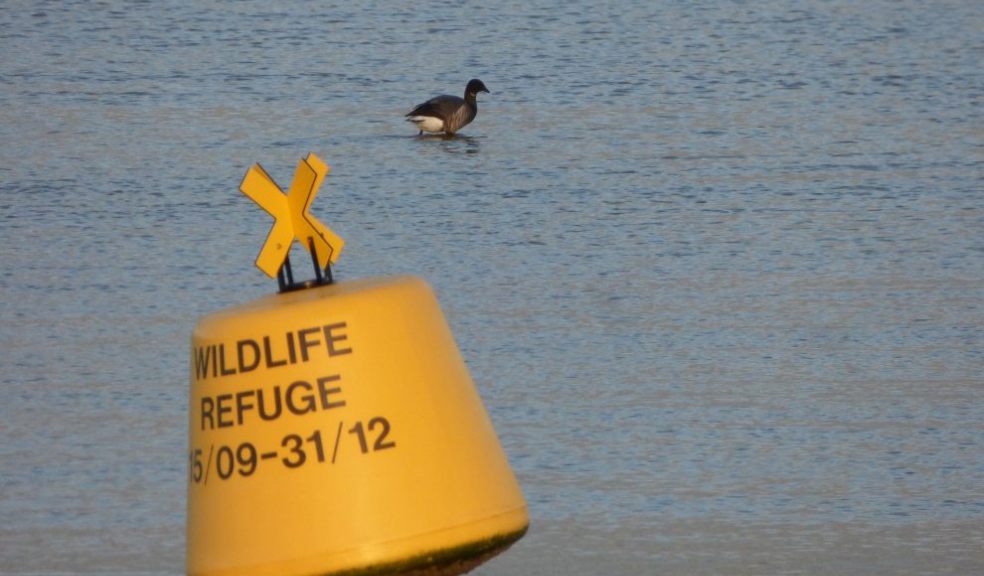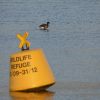
Three years of Exe Estuary wildlife refuges are working
The two wildlife refuges were set-up three years ago to ask all visitors to avoid these areas at certain times of the year: all year round off Dawlish Warren and between 15th September and 31st December at Exmouth Duckpond.
The results of a three-year monitoring programme have revealed that the wildlife refuges are working and show that people have mostly complied with requests to stay out of the areas.
The results showed that the wildlife refuges significantly reduce disturbance to protected bird species on the Exe Estuary. In addition, the results indicate that the wildlife refuges are in the right places and cover the most critical times of year for protected birds. Evidence showed that the maximum numbers of wildfowl (ducks, geese and swans) recorded at the Exmouth refuge showed an annual increase over the three years of the study. It means that the Estuary is better able to provide undisturbed resting and feeding sites for these birds into the future.
Unsurprisingly, the results were affected by the Covid-19 pandemic – both from numbers of people having reduced access during lockdowns and conversely by staycations increasing the number of people on the Estuary when lockdown ended.
Councillor Martin Wrigley, Chair of the South East Devon Habitat Regulation Executive Committee and Teignbridge Executive Member for Communities, Housing and IT, said: "The latest monitoring reports show great results for the wildlife on the Exe Estuary, and that the wildlife refuge spaces are having an impact. It has been great to see so many people out on the water enjoying and sharing the area with the birds.
"Through showing consideration for others – including the wildlife – we can continue to keep the Exe Estuary, Dawlish Warren and the Pebblebed Heaths the special places they are for generations to come."
The surveys were carried out by independent ecologists, Footprint Ecology, who started monitoring the Exe Estuary before the wildlife refuges were in place to compare the situation before and after their introduction. Read the full report.
The survey report showed:
- More wildfowl were found within the wildlife refuges when they were active than when they were not. The total number of wildfowl using the Exmouth wildlife refuge when it was active increased over the study period. Total wildfowl numbers have increased within the Dawlish wildlife refuge since its activation. These results imply (although based only on 3 years data) that the wildlife refuges are becoming more important for birds over time.
- The number of events with the potential to disturb birds has decreased following the implementation of the wildlife refuges.
- Some disturbance is still taking place and when this occurs it is more likely to result in birds being flushed from the area and taking flight.
- Most incursions into the wildlife refuges occurred when the ranger team was not visible. This suggests that the presence of the ranger team means more people will avoid the wildlife refuge areas. The effectiveness of the wildlife refuges is also likely to depend on additional factors such as wardening, signage, education, awareness raising, etc. However, some incursions still take place when the rangers are present.
- The wildlife refuges play an important role in providing feeding and roosting habitat for the protected birds. The wildlife refuges ensure that a range of disturbance-reduced areas are always available for birds to use. However, it is clear that the wildlife refuges on their own are not a panacea to completely address the impact of recreation, but that they fit within a package of measures.
- The importance of the wildlife refuges is likely to change with time, particularly if the number of incursions continues to reduce. The use by birds will likely be affected by changing conditions around the Estuary and also be dependent on the levels of disturbance in other parts of the site. The pandemic has highlighted how access levels and types of use can change in unexpected ways and it is not clear how access levels might further change in the future, in the post-pandemic period.
- The number of birds using the wildlife refuge areas and the Estuary is not only affected by recreational activity. Variation in bird numbers year to year may be affected by a range of different factors, including adult survival, breeding success, as well as food availability, water quality, and climatic impacts.
You can do your bit to keep the Exe Estuary special for years to come by keeping out of the wildlife refuges and following the codes of conduct for the area.
Decisions made by SEDHREC are subject to a call-in by the three councils for a period of 5 days following the meeting.













